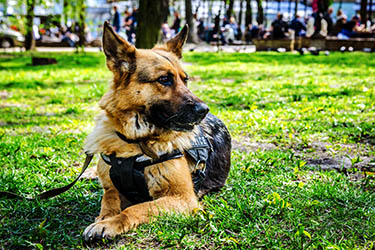Trained for the K9 Corps

The K9 Corps consists of dogs that receive specialized training in order to work within the military. These animals can be found performing duties alongside of soldiers who have also completed training to become a K9 handler.
History
The first dogs to be inducted into military service arrived following the 1942 bombing of Pearl Harbor. Of the thirty breeds that were initially accepted, the following five breeds were chosen to receive training:
- German Shepherds
- Belgian Sheep Dogs
- Doberman Pinschers
- Farm Collies
- Giant Schnauzers.
Within these breeds, animals that passed the requirements went on to receive training in one of the following four specialized programs:
- Sentry. A sentry dog was taught to warn of the presence of a stranger by signaling a warning shown by standing alert, growling or barking
- Scout or patrol. Trained for skills similar to a sentry dog, a scout or patrol dog was chosen for its ability to work in silence by signaling the message of a stranger through stiffened body, raised hackles, rigid tails or pricked-up ears
- Messenger. Messenger dogs were trained to work with two handlers and possessed the ability to move quickly and stealthily. These dogs proved to be an effective means of carrying essential information from one point to another
- Mine. These dogs were trained to uncover mines, tripwires, and booby traps.
Dogs in the K9 Corps Today
The breed of dog most used in the military today is the German Shepherd. Known to be highly intelligent, loyal, and moderately aggressive, the breed is easily trained and has shown it can readily adapt to most environments. Other breeds widely preferred for their abilities to detect odors include the Labrador, Golden, and Chesapeake Bay Retrievers.
Dogs that are trained and used for the K9 Corps come from the 341st Military Working Dog Training Squadron at Lackland Air Force Base in Texas. These animals perform many different duties and can be found working in military roles, such as the following:
- Combat Tracker Dog (CTD)
- Trained to work on a long retractable leash, these dogs are able to trace explosives back to the person who set them
- Used with the Marine Corps only
- Explosive Detector Dog (EDD)
- Trained to work on leash with their handler to detect explosives
- Used within all of the military branches
- Mine Detection Dog (MDD)
- Trained to search off-leash for buried mines and artillery
- Used in the U.S. Army only
- Multi-purpose canines (MPC)
- Used by personnel in Special Operations
- Trained to detect bombs and patrol, these animals also receive training to, for instance, parachute, rappel or wear specialized cameras and other equipment that passes information to the handler
- Narcotics Detector Dog (NDD)
- Detects narcotics
- Used within all military branches
- Patrol Explosive Detector Dog (PEDD)
- Trained to detect bombs and patrol, these dogs are primarily used by the Military Police and service law enforcement
- Patrol Narcotics Detector Dog (PNDD)
- Trained to detect narcotics
- Used within the U.S. Army, Navy, Air Force, and Marine Corps
- Specialized Search Dog (SSD)
- Trained to work off leash and even away from handler to detect explosives
- Receives communication from the handler via hand signals or auditory commands issued through a radio receiver worn on their backs
- Used within the U.S. Army and the Marine Corps.
Specialized training allows these highly intelligent animals to perform many different roles. Their abilities and presence add to the success of the military.
Careers
Are you looking for a place to let your talents shine? At Covetrus, we help our practitioner customers better serve their patients and take pride in providing the best customer experience possible. Search our open positions to see our available opportunities.
Newsletter
Stay current with what’s going on with Covetrus, subscribe to receive our newsletter and email communications. Subscribers will receive the latest information in practice management, sales and marketing, animal health, and more.


Leave a comment